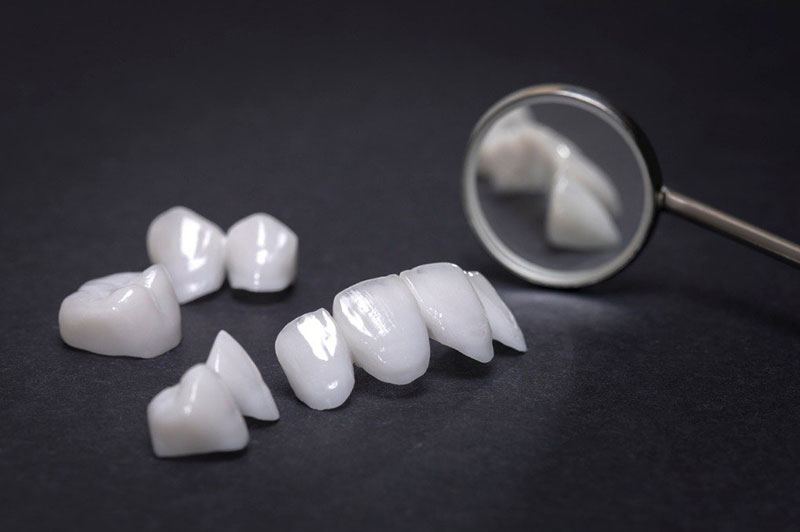Dental veneers are the best aesthetic solution for correcting the color, shape, and size of teeth. They are an excellent choice for correcting gaps between teeth as well. The advantage of veneers is minimal grinding since they only cover the front surface of the teeth, unlike other prosthetic replacements, and they offer a high degree of aesthetics.
What are dental veneers?
Dental veneers are thin layers of porcelain or other materials that are placed on the front surface of the teeth for aesthetic correction or to enhance the appearance of the teeth. They are often used to change the shape, size, color, or position of the teeth, making the smile bright and attractive. Dental veneers are customized for each patient and can be permanently cemented to the teeth after preparation.
When are dental veneers used?
Dental veneers are used in various situations for aesthetic correction or to enhance the appearance of teeth. Some situations where they can be applied include:
- Disproportionate teeth: If some teeth are disproportionately small, large, or have irregular shapes, dental veneers can be placed to achieve harmony and balance in the smile.
- Worn teeth: Dental veneers can be used to achieve a brighter tooth color and improve the aesthetics of the smile for patients who want a whiter smile.
- Enamel damage: If the front surfaces of the teeth are damaged with small cracks, chips, or enamel erosion, dental veneers can be used to cover these imperfections and restore the appearance of the teeth.
- Irregular teeth positioning: For patients with slight irregularities in teeth positioning, dental veneers can provide a quick and less invasive option for correction, instead of undergoing orthodontic treatment.
- Gaps between teeth: Dental veneers can be used to cover minor gaps between teeth, filling in spaces and achieving balance in the smile.
- Damage from bruxism: Patients who suffer from bruxism (clenching or grinding of teeth) often have advanced wear on the front teeth. Dental veneers can help in restoring damaged surfaces.
- Aesthetic transformation: For those who desire a complete aesthetic transformation of the smile, dental veneers can be an integral part of the aesthetic treatment.
It’s important to note that dental veneers are usually placed on the front teeth and are used for aesthetic purposes. The decision to use dental veneers should be made with the advice of a dentist who will assess whether dental veneers are an appropriate option for your specific situation.
What types of dental veneers are available?
There are different types of dental veneers used for aesthetic corrections and to improve the appearance of teeth:
- Porcelain (ceramic) veneers: These are the most commonly used veneers. They are made from thin layers of porcelain and provide a natural appearance of teeth. Porcelain veneers are durable and long-lasting.
- Composite veneers: Composite veneers are made from composite material similar to that used for teeth whitening. They are shaped directly on the tooth and often require less grinding of the tooth compared to porcelain veneers.
- Pressed veneers: These veneers are made from pressed porcelain, making them particularly strong and resistant to breaking.
- Non-prep veneers: Non-prep veneers, also known as minimal or no grinding, require minimal or no grinding of the tooth before placing the veneers.
- Veneers for gap filling: These veneers are used to fill gaps between teeth, providing a more even smile.
- Layered veneers: These veneers have additional layers of ceramic that are placed on the front surface of the teeth to achieve the desired aesthetics.

Each type of veneer has its advantages and limitations, and the choice depends on your needs, desires, and the recommendation of the dentist. The dentist will help you choose the most suitable option for your specific situation.
What is the procedure for installing dental veneers?
The procedure for installing dental veneers usually consists of several steps that can be summarized in the following process:
- Examination and consultation: The first step is a visit to the dentist for an examination and consultation. You will discuss your goals and desires, and the dentist will assess your oral situation to determine if you are a candidate for dental veneers.
- Treatment planning: Based on your goals, the dentist will discuss options with you and choose the appropriate design and color of veneers. You will also receive information about the expected appearance and duration of the treatment.
- Tooth preparation: To prepare the teeth for veneers, the dentist may need to remove a thin layer of enamel from the front surface of the teeth. This grinding helps ensure enough space for placing the veneers.
- Tooth impression: After grinding, the dentist will take a precise impression of your teeth. This impression will be used to create customized veneers in the laboratory.
- Temporary veneers: In some cases, the dentist may place temporary veneers while the permanent ones are being made in the laboratory. Temporary veneers protect the prepared teeth and allow normal functioning while the permanent veneers are being made.
- Fabrication and adjustment of veneers: In the laboratory, customized veneers will be made based on the impression of your teeth. When the veneers are ready, the dentist will carefully adjust and check how they fit.
- Placing the veneers: When the veneers are ready, temporary veneers will be removed, and the new veneers will be permanently cemented to the prepared teeth. The dentist will carefully place each veneer and check the proper bite and appearance.
- Final adjustments: The dentist will check how the veneers fit in your bite and how they look in the oral cavity. If minor adjustments are needed, the dentist will make them to ensure optimal function and aesthetics.
- Care and maintenance: After placing dental veneers, it’s important to regularly maintain oral hygiene, visit the dentist regularly, and follow recommendations for the care of veneers to ensure their longevity and aesthetic appearance.
Are there any side effects of installing dental veneers?
Although dental veneers are generally a safe dental treatment, some side effects or complications can occur, although they are relatively rare.
- Tooth sensitivity: After placing veneers, some people may experience temporary sensitivity to hot, cold, or sweet. This usually passes within a few days or weeks.
- Bite difficulties: Improperly placed veneers can lead to bite problems or discomfort while chewing. It’s important to inform your dentist if you notice any changes or discomfort in your bite.
- Poorly fitting veneers: Sometimes veneers can be too thick or not sufficiently adjustable, which can cause discomfort or difficulty in properly cleaning the teeth.
- Veneer damage: Veneers are quite durable, but they can be damaged if trauma occurs, for example, if you accidentally bite hard food, open objects with your teeth, or experience a blow.
- Damage during placement: During the placement of veneers, there may be damage to the teeth or existing dental work, although this is rare.
- Color changes: Ceramic veneers are resistant to stains, but composite veneers may change color or stain over time.
- Infection or gum irritation: Improperly placed veneers or the accumulation of bacteria under the veneers can cause infection or irritation of the gums.
During the conversation with the dentist, it’s important to clarify possible side effects before deciding to place dental veneers. The dentist will provide you with all the necessary information and advice so you can feel confident about your treatment.
For any additional information, follow the blogs of the MB Dent clinic. If you would like more information from Dr. Matko Božić and his team, write to us at info@mbdent.com, WhatsApp 095 3634 337, or call us on the phone number 01 35 35 435 or mobile 095 3634 337.


